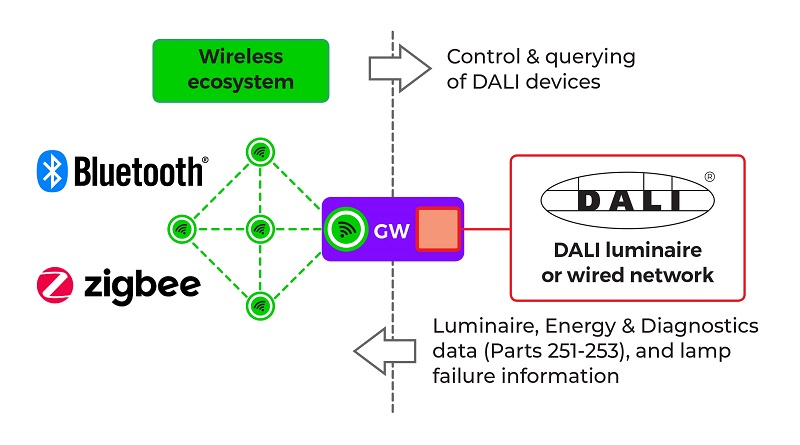




October 22, 2021
DALI has become one of the most popular open protocols for digital lighting control. Based on the open global standard IEC 62386, DALI was originally designed for wired networks, but more recently it has broadened its scope to cover wireless networks.
DALI is managed by the DALI Alliance, which has provided two ways to use wireless connectivity for lighting control. In another Blog post, we discussed the DALI+ specification that enables wireless and IP-based networking – and in this post, we’ll look at the alternative approach, based on using gateways between DALI and wireless networks.
Technical Guide: Wireless to DALI Gateways |
|
|
| >> Download the Technical Guide on DALI Gateways |
The DALI Alliance has specified two Wireless to DALI Gateways, which enable existing wired DALI devices to be used in a non-DLAI wireless ecosystems. DALI has specified two such gateways, with Bluetooth Mesh and Zigbee as the wireless ecosystems. The two gateways operate in a similar manner, translating commands from the wireless side to enable control and querying of the DALI devices.
Figure 1 shows how a gateway (GW) participates in the wireless ecosystem and also contains a DALI application controller that connects to devices on the wired DALI network. The gateway architecture enables the wireless ecosystem to control and query DALI control gear, as if the DALI devices were part of the wireless network.
The DALI devices are automatically discovered and addressed by the gateway, before joining the ecosystem network. Security is ensured by the existing features of Bluetooth or Zigbee.
In operation, the wireless devices talk to the gateway using their existing (Zigbee or Bluetooth) protocol. They can control light output and fading of DALI devices via the gateway, and can read lamp failure information from the DALI devices, as well as selected data from Parts 251-253 (luminaire, energy and diagnostics data).

| Figure 1: Gateway (GW) between a non-DALI wireless ecosystem (Bluetooth mesh or Zigbee and a DALI system, which could be a wired subnet or one or more DALI-2 or D4i luminaires, for example. |
It’s worth pointing out that gateways don’t make wireless ecosystem devices appear as if they are part of the DALI system. This means that application controllers in the DALI system cannot control, configure or query ecosystem devices.
As explained in the Technical Guide, gateways can support several system architectures. A simple case is to mount a gateway onto a D4i luminaire. Ecosystem devices can control the light level of the luminaire, and can access much of the data provided by the DALI control gear. The gateway can be powered from the DALI bus, or by an external supply. .The wired DALI system can also consist of multiple DALI-2 subnets, to provide more flexibility and support a higher number of devices.
As things stand today, commands can be broadcast to all DALI devices via the gateway. Future versions of the specification are likely to enable the individual addressing of each device. This would add the capability to individually control the light level of each device, as well as supporting event messages from input devices.
So far, the DALI Alliance has published two new gateway specifications: Part 341, covering Bluetooth Mesh to DALI gateways, and Part 342, describing Zigbee to DALI gateways. The Alliance is also considering adding support for other wireless ecosystems.
For any particular system, there are multiple reasons why wired, wireless, or a combination may be the right answer. Similarly, wireless connectivity may be best provided using one or more gateways, or with the DALI+ option. By developing both approaches, the DALI Alliance has given designers the flexibility to match the control system to their specific requirements.
Links |
| >> More about Wireless to DALI Gateways |
| >> Download DALI+ Specifications |
| >> Download Technical Guides (DALI+ Systems and Wireless to DALI Gateways) |
| >> DALI Blog on DALI+ |
► Sign up to join our mailing list and receive our newsletter
► Follow the DALI Alliance on LinkedIn or join the LinkedIn DALI Group